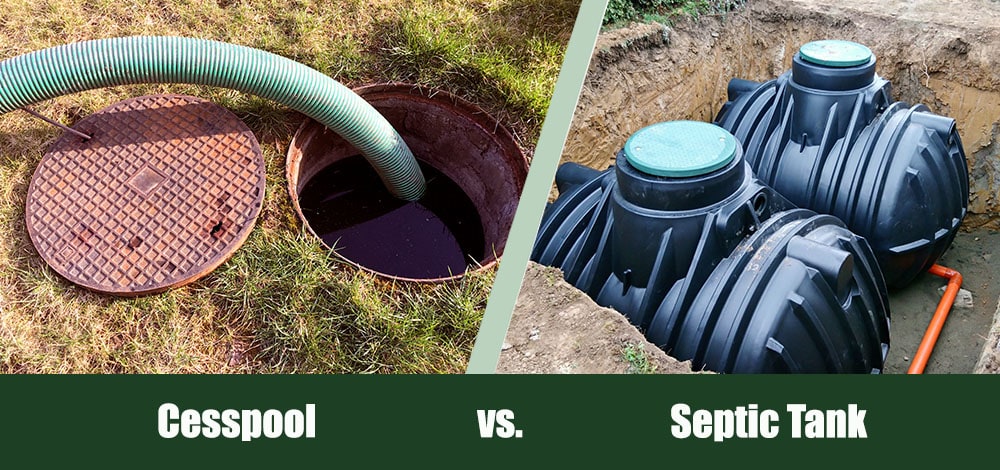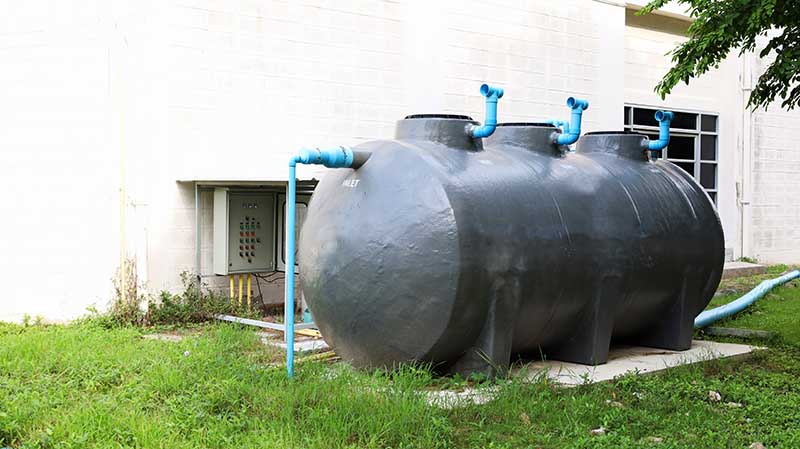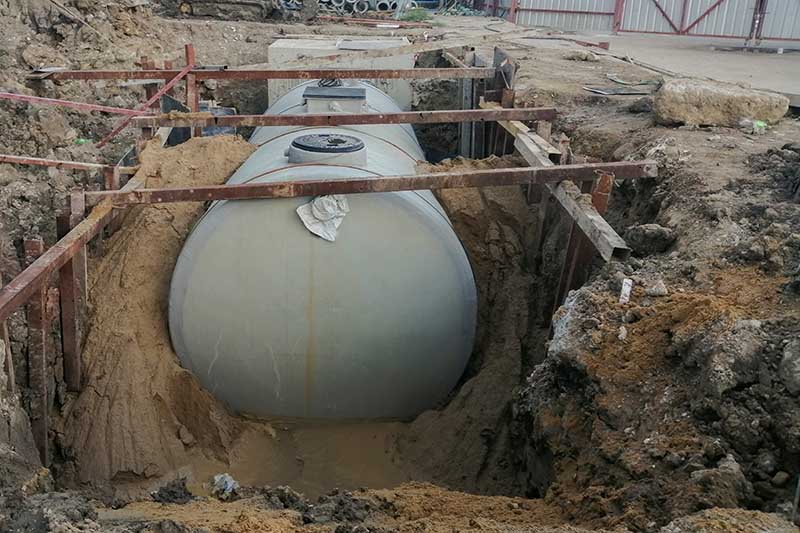Cesspool vs Septic Tank: Which One Should You Choose?
-
Pete Ortiz
- Last updated:

One of the things you think about when building a dream home is what type of septic you should install. Of course, your first question is whether it’s better to use a cesspool or septic tank.
A cesspool and septic tank serve the same purpose. They provide a method to dispose of human waste. A common misconception is that they’re the same thing, but there are many differences between the two systems that make them better or worse for different scenarios.
You’re in the right place if you’re wondering whether it’s better to use a cesspool or a septic tank. Both have advantages and disadvantages, which could affect your decision on which one to install in your home. But don’t fret! We are here to help you!
Click below to jump ahead:
At a Glance

- Wastewater is dumped in a small region
- Not helpful when it comes to sewage disposal
- Wastewater is dumped in a wide region
- More helpful for sewage disposal
- Has filtration
Overview of Cesspool
Cesspools, also known as cesspits, are underground wastewater disposal systems. In other words, a cesspool is an open hole in the ground lined with stone or concrete, filled with gravel and sand, sealed with tar, and covered over with dirt.
Usually, a cesspool is found in places where the ground is not suitable for installing a septic tank, such as on a sloping ground or near a river or lake.
The primary function of cesspools is to collect and store human waste that flows into them from the house’s drain system. The solid material remains in the cesspool, while the liquid flows into the soil and groundwater.

How Does a Cesspool Work?
A cesspool works in much the same way as a septic system does. Waste enters through perforated pipes and settles out into layers at different depths within the cesspool structure. A cesspool collects wastewater and lets it sit in the tank until it’s treated by naturally occurring bacteria.
The organic matter in the wastewater decomposes in this anaerobic environment. Then, it produces methane gas as one of the byproducts of this process. After a few days, the water leaves the tank through a pipe that goes into the ground.
Consult a PLUMBING expert
Find a plumbing specialist in your area, and get free, no-commitment estimates for your project.

What Is a Cesspool Good For?
Cesspools have been used for centuries as part of an on-site waste management system. They’re often found in rural areas where there are no municipal sewage treatment services.
Cesspools collect raw sewage. So, licensed contractors must empty them periodically so they won’t overflow with wastewater and become hazardous to people living nearby or damage property. Cesspools are also good for disposing of sanitary waste.
- Sewage Flow: A cesspool allows sewage to flow down into its center by gravity. So, no pumping is needed. But you may choose to pump out your cesspool periodically to remove solids settled at the bottom of the tank. It can help prevent odors and keep waste from building up inside your tank over time.
- Material: Usually, cesspools are made of concrete, although they can also be made of brick or clay. The material used depends on the type and quality of the cesspool being built. Some can also be made of stone or cement.
- Detention Period: It’s the amount of time the wastewater sits in the cesspool before it’s pumped out. Usually, this time ranges from 24 to 48 hours, depending on how much liquid waste is entering your tank regularly and how much oxygen is in your environment.
- Sludge Withdrawal and Disposal: When the cesspool fills up with sludge, you must pump out the sludge into tanker trucks and take it to a landfill site for disposal. This process is complex and expensive. So, many people opt for septic tanks instead, which don’t need pumping out.
- Cesspools Don’t Treat Wastewater. They collect it until it can be pumped out into a field or other suitable location for disposal.
- Concentrates wastewater in one area
- Don’t take a lot of space
- Easy to install
- Fit for areas with poor soil
- Causes groundwater contamination
- High maintenance cost
- Prone to sewage overflow and backup
Overview of Septic Tanks
A septic tank is a watertight container buried in the ground. It breaks down toilet waste. The solid waste settles to the bottom of the tank and the liquid is dispersed into underground leaching fields.
The septic tank has an infiltration field or leach field that filters out solids from the wastewater. It allows it to percolate through the soil to a groundwater aquifer.
The wastewater may also be discharged into surface waters after treatment at a facility licensed by the state or municipality.

How Does a Septic Tank Work?
A septic tank collects wastewater through a pipe and breaks it down with natural bacteria. As the wastewater enters the septic tank, it passes through a baffle that slows down incoming flow. This way, it lets solids settle in the bottom of the tank.
Then, the liquid makes its way through a septic drain field (a network of perforated pipes buried in trenches or raised beds). Here, it’s further broken down by aerobic bacteria. The bacteria convert organic matter into carbon dioxide, water, and other substances that enter the soil.
What Is a Septic Tank Good For?
Septic tanks are an essential component of your home’s plumbing system. They’re good for storing wastewater from your home. This way, they let solids settle at the bottom. The septic tank has a crucial role to play in our lives. It helps us dispose of our waste well.
- Sewage Flow: The sewage flow in your home’s plumbing system will determine how many gallons of water you need for your septic tank. The septic tank has a fixed volume, which limits the use of water for flushing toilets. Most septic tanks have a sewage flow of nine liters per minute.
- Tank Capacity: The septic tank’s purpose is to provide a place for the waste to decompose and disperse effluent into the ground. A septic tank system consists of several components, including the septic tank itself, a distribution box, an outlet pipe, and a drain field. The capacity of septic tanks ranges from 70 to 130 liters per head.
- Detention Period: The detention period of a septic tank is usually 24 hours. It can also range from 12 to 48 hours. The period is affected by several factors including the size of your septic tank, the number of people in your household, how often you flush, and what type of toilet you use.
- Sludge Withdrawal and Disposal: Sludge is material that floats on top of the effluent in the septic tank. Usually, it’s composed of digested sludge, fats, grease, and other organic materials. You can remove this sludge from the tank through a scum or grease trap installed at the outlet end of the tank. You should remove it every six months. It’s done to prevent solids from entering your leach field. The sludge must be disposed of well so as not to pollute water sources or soil.
- Durable
- Cost-efficient
- Eco-friendly
- No monthly maintenance costs needed
- You can install it in any location
- Drainage pipes may rupture
- Can clog
Differences Between a Cesspool and a Septic Tank
Cesspools and septic tanks are both wastewater collection methods. But there are some key differences between them as seen below:
Water Treatment
Cesspools dispose of liquid waste from a building or home. It is usually installed in the ground and filled with water. The water then seeps into the soil and is filtered over time by natural processes.
Septic tanks are also used for liquid waste disposal, but they are made to treat the water as it passes through instead of allowing it to soak into the ground.
Cleaning and Maintenance
Cesspools have concrete or brick walls. So, they need more frequent cleaning than septic tanks. Usually, septic tanks need to be cleaned once every three years or so, but may need more frequent cleaning if there’s an increase in the amount of waste produced by your household.
Durability
One primary difference between cesspools and septic tanks is durability. Cesspits are not designed to last more than 15 years. It’s because they are exposed to harsh elements such as freezing temperatures, heavy rain, and snowmelt.
On the flip side, septic tanks usually last 20–30 years. That’s because they’re located underground away from harsh weather conditions.
Installation Cost
Septic tanks are installed by professionals. Also, they’re more expensive than cesspools because they need underground piping and a pump station. The installation cost for both systems, however, depends on the size of your home and the type of soil it’s located on.
Filtration
Septic tanks have filtration while cesspools don’t. The purpose of this filter is to remove solid materials like hair, oil, and grease from wastewater before it enters the soil through a leach field.
Size
Another difference between a cesspool and a septic tank is the size. Cesspools are smaller than septic tanks. The septic tanks are located off-site from the home to store wastewater before it is treated.
Location
You can install a cesspool on your property if you live in an area with no municipal sewer service available. On the other hand, a septic tank needs to be installed off-site. This way, there is room for it to collect wastewater before treating it with anaerobic bacteria.
If you live in an area with municipal sewer service available, it may be cheaper to install a septic tank rather than a cesspool.

Factors to Consider When Installing a Cesspool or a Septic Tank
Design and Type
Before installing the cesspool or septic tank, consider its design and type. If you want privacy around your property, choose a vault-type tank buried underground. But, if this is not possible, you can opt for an above-ground design that doesn’t cover all of its sides with soil but has some parts exposed above ground level.
Terrain
The terrain where you live also determines whether you should install a cesspool or a septic tank. A septic tank needs level ground for installation. On the other hand, a cesspool can be installed on uneven terrain and in flat areas where there are no obstructions.
Ease of Access
The first thing that comes to mind when talking about ease of access is its location. Make sure it’s located in a place where it won’t cause any inconvenience to anyone else. Choose an area that’s accessible to you at all times. It includes having easy access to your septic tank whenever it needs cleaning, repair, or replacement.
Tank Size
The size of your tank determines how much wastewater you produce and how often you use it. It means that if you produce less waste than expected, it’s likely that your sewage will back up into your house through the drain pipes leading into your property.

Cesspools vs Septic Tanks: Which Is Right for You?
If you’re considering a new septic system, you may be wondering if a cesspool or septic tank is right for you. Both systems use gravity to move wastewater from your home into the ground through pipes. But which is right for you?
A septic tank is better than a cesspool because it treats wastewater before discharging it to the outside environment. Besides, the wastewater released by a septic tank is filtered, so it won’t cause harm to the environment.
- Building a new home in your rural area without connection to the city or municipality sewerage system.
- When you have a manhole.
- If you want a non-conventional solution for your sewage.
- If you want to treat and store wastewater without access to a sewer system.
Conclusion
As you have probably gathered by now, the cesspool and septic tank are closely associated. It’s easy to confuse them, but there are crucial differences between the two.
Both the cesspool and the septic tank are undoubtedly helpful for our living. Choosing between these two options can be confusing at first.
But if you know what to look for, it’ll be easy for you to select from either of these two options. With that in mind, the best advice we can give is to consult a professional to determine what type of system best suits your needs.
Featured Image Credit: (L) Dagmara_K, Shutterstock | (R) Hamik, Shutterstock
Contents





